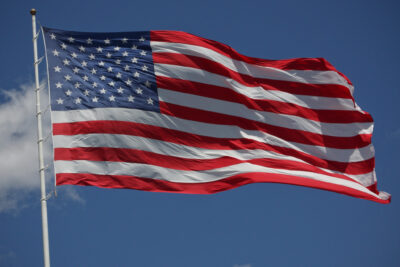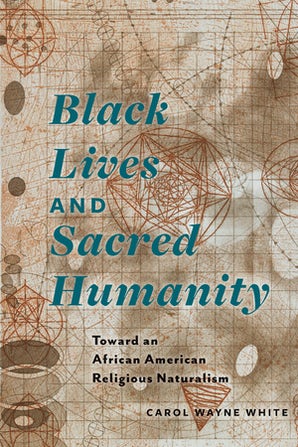Reading Carol Wayne White’s Black Lives and Sacred Humanity: Toward an African American Religious Naturalism during summer 2020 was an extraordinary experience. The work’s very title became manifest and embodied. After the murders of George Floyd, Breonna Taylor, and Ahmaud Arbery, Black lives poured into the streets. They were joined by those who understand the way Black lives matter and are systemically denied value in the United States. White’s account of a tradition of African American religious naturalism—running through figures such as Anna Julia Cooper, W. E. B. Du Bois, and James Baldwin—offers a crucial frame for the shouts and the sweat and the desire that was evinced in public spaces over these last months.
For White, African American religious naturalism is a tradition of sacredness that emerges out of the conjoined efforts of Black people to resist anti-Blackness. On this account, sacredness comes neither from the saving power of a transcendent deity, nor is it located in an atemporal afterlife. The sacredness of African American religious naturalism “has to do with fundamental ways of conjoining with others that transforms us.” Sacredness is a natural achievement, not a metaphysical given, that stems from realizing human entanglements, interwovenness, and mutual dependence. It takes the form of here-and-now poetic, political, and social expressions of those entanglements. And when it does break into view, it forms natural landscapes as grand and as capable of inspiring awe, wonder, and gratitude as the Grand Canyon.
White’s work does not mention BLM, but by her terms, humanity was made sacred this summer by BLM’s confrontation with the ways that anti-Blackness saturates and deforms Black existence in this country.
As a white man I kept asking myself: why now? What about this moment led to this public accounting of the way anti-Black violence deprives Black life of breath? Why did white people, in greater and more sustained numbers than I have ever seen, become alert, at least momentarily, to the ways anti-Blackness demands a reckoning? I found myself wondering what it means to see injustice, what are the conditions of its recognition? White’s work pushes us to address these questions in a radical and different fashion. White insists not only that we see injustices as deformed natural landscapes, but that we are only able to see them when we perceive them as such. In turn, White’s work suggests that something about the natural landscape—which is to say the grounds on which we understand our interdependence—began to be transformed this spring and summer.
When I asked my friends this question—what is being transformed in our natural landscape?—several spoke about the video of George Floyd’s murder as a singular graphic horror. It is that. But there is no shortage of American anti-Black horror films, each one a singular graphic monstrosity. Others said that the pandemic set the conditions for historically unprecedented and sustained multiracial protests. The logic is this: Lots of people were sitting around unable to work, stuck at home, and this became a moment—politically ludic—for people to take to the streets. I am sure you have heard a version of this. The pandemic has provided the right social conditions for mass protest. Fenced-in energies exploded in the form of political expression. In other words, the onset of the pandemic was something like a capped tea kettle, confining us and restricting us from the world, until it burst.
It was only when reading White’s chapter on Anna Julia Cooper, the nineteenth-century feminist and author of A Voice from the South, that I realized how partial and limited this reading is of this summer’s mobilization. The “capped tea kettle” model only understands the pandemic as a force that confines. This model does not acknowledge or directly wrestle with the pandemic as a very particular and devastating natural occurrence. White’s reading of Cooper emphasizes the way that Cooper constantly looked to nonhuman nature—“the beautiful curve of the planets,” the “air we breathe,” “fiery, never-resting, all-corroding oxygen,” and “sluggish, inert, nitrogen”—but not as Romantic effulgences that pull us out of human history and political station. Instead, Cooper understood nonhuman natural processes as sites to critique human relations. The curves of the planets, the air we breathe, and the water we drink are “the resultant of their conflicting forces.” For Cooper, these seemingly stable and smoothly functioning natural events must be understood as products of dynamic conflict and complex interactions and relations. In turn, Cooper understood humans—themselves natural beings subject to natural forces—as similarly enmeshed within these roiling natural conflicts and systems of relations. White writes: “A cluster of ideas focused on nature’s movements, chief of which is the observation that a nexus of relations constitute nature, artfully shapes this perspective . . . emphasizing the key metaphor of relationality to describe the fundamental truth of human life.” Humans for Cooper are vulnerable creatures, not invulnerable sovereign selves. When White tells us that for Cooper “what was so deplorable about any form of discrimination was its systemic silencing and tyrannical imposition upon natural forces and vital processes that inherently desired to fulfil themselves,” Cooper suggests that racist practices obscure, through thick veneers of homeostatic political “normalcy,” life-giving human relatedness.
White’s reading of Cooper fits into the tradition of “radical Romanticism” that Mark Cladis traces in his recent work.1“Into the Wild: Environmental and Racial Justice,” in Radical Romanticism, Columbia University Press, forthcoming) For Cladis, Henry David Thoreau, Mary Wollstonecraft, and especially Du Bois, “wilderness” is not a “sublimely looming out there, outside human dwelling and activity, but rather is found closer to home—in our lands, our communities, our cities, our bodies.” Cladis argues that Du Bois’s use of ecology in his writings—landscapes such as the Grand Canyon, swamps and forests of both Africa and the United States, and rural roads and soil that are both bloody and rich—functions “as a source of dignity, cultural vigor, and social protest.” That is, like Cooper, Du Bois looks to nonhuman sites of the natural as a way to plumb the depths of American anti-Blackness and then “fire the imagination” for a renewed vision of justice. Both White and Cladis’s accounts of a radical tradition of religious naturalism suggests there is something intrinsic to living through a pandemic that led to the explosion of protests to value Black lives. On these terms, the pandemic is a natural wilderness that presses its unremitting dynamics on our human dwellings. Black Lives Matter is leading people into the streets, like so many Coopers and Du Boises, to remake the world according to a new naturalized vision of justice.
Living in New York City, during the early days of the pandemic, I was flabbergasted at how quickly the virus spread through nothing more than simply breathing, giving the lie to self-reliance and impressing upon us all our literal interrelation. The virus reinforces the way we exist in habit and practice with each other. Riding the subway (before I didn’t), I thought: I am not me without you, and I never realized this so fully before. And as the virus has torn through communities, the particulars of me’s and you’s have come into awful focus. Brown and Black communities bear the terrible burdens of interdependence, as they always have on these shores, as the virus winds itself around white systems of white supremacy. The pandemic—a wilderness—forces us to confront the wilderness of our social and political birthright. Led by Black and Brown people, protestors entered into this wilderness in an effort not to tame it, but to change it wholly. Protestors conduct daily natural experiments in living to produce a new type of wilderness, a natural order that prioritizes the histories and needs of the dominated.
White writes about the way that “meeting someone on the street puts you face to face with a manifestation of myriad cosmic meanings…you and I are important aspects of the evolving, unfolding stream of life.” For me, that feeling was acute in the streets this summer. It is an experience of an emerging natural order that is capable of provoking feelings of awe and reverence. Pregnant in BLM marches, in the face to face looks I experienced, is the question: How are we going to relate to each other anew? How ready are we to build our “conflicting forces,” to recall Cooper, into something of sacred beauty?
Finally, if the pandemic has divulged a wilderness of human doing, and offered moments to create a new wilderness of human natural relations, it also laid bare our ultimate exposure to the nonhuman natural forces. These forces will eventually render us humans defenseless. It put me in mind of Aimé Césaire’s line from Notebook of a Return to the Native Land: “At the end of the wee hours, the volcanoes will explode, the naked water will bear away the ripe sun stains and nothing will be left but a tepid bubbling pecked at by sea birds—the beach of dreams and the insane awakenings.” Visions of justice can seem insane. As vulnerable natural beings, we have a limited time to enact them. Now is as good a time as any to manifest insane dreams and awakenings.














